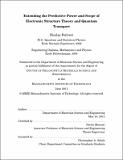Extending the predictive power and scope of electronic structure theory and quantum transport
Author(s)
Poilvert, Nicolas (Nicolas Alain Pierre-Yves)
DownloadFull printable version (3.415Mb)
Other Contributors
Massachusetts Institute of Technology. Dept. of Materials Science and Engineering.
Advisor
Nicola Marzari.
Terms of use
Metadata
Show full item recordAbstract
The day 1998 Nobel Prize recipient Walter Kohn wrote his first article on Density Functional Theory, he could never have predicted its eventual impact on computational materials science. Almost 50 years after his original article, the field has seen tremendous improvement both in computer hardware and in software algorithms, and the resulting combination of an elegant theory and truly predictive power has enabled accurate, reliable simulation of relevant materials properties. But the story does not end here. Density Functional Theory still needs major improvements in at least two directions to really add the power of ab-initio quantum mechanics to the toolbox of materials engineers. The first direction aims at improving the accuracy of predicted materials properties, while the second aims at improving the scope of firstprinciples predictions. In this work, an attempt to push the field forward in each of the directions outlined above is set forth. A novel scheme that drastically reduces self-interaction errors in Density Functional Theory, and re-establish physical meaning in Kohn-Sham orbital energies is presented. The accuracy of the newly developed functional is shown to remedy a lot of the known deficiencies of local and semi-local functionals, while preserving their intrinsic qualities on established properties. A second key contribution from this work has been the development of a set of robust and efficient algorithms for large scale quantum transport calculations within Density Functional Theory combined with the Non-Equilibrium Green's Function formalism. Emphasis on user-friendliness was an underlying motivation throughout the implementation phase into the Wannier90 code. Systems with sizes up to two orders of magnitude larger than what DFT can currently deal with can now routinely be investigated. The automation of the whole process also opens up the possibility for high-throughput quantum conductance calculations with potential usefulness in the field of nanoelectronics.
Description
Thesis (Ph. D.)--Massachusetts Institute of Technology, Dept. of Materials Science and Engineering, 2011. This electronic version was submitted by the student author. The certified thesis is available in the Institute Archives and Special Collections. Cataloged from PDF version of thesis. Includes bibliographical references (p. 186-193).
Date issued
2011Department
Massachusetts Institute of Technology. Department of Materials Science and EngineeringPublisher
Massachusetts Institute of Technology
Keywords
Materials Science and Engineering.